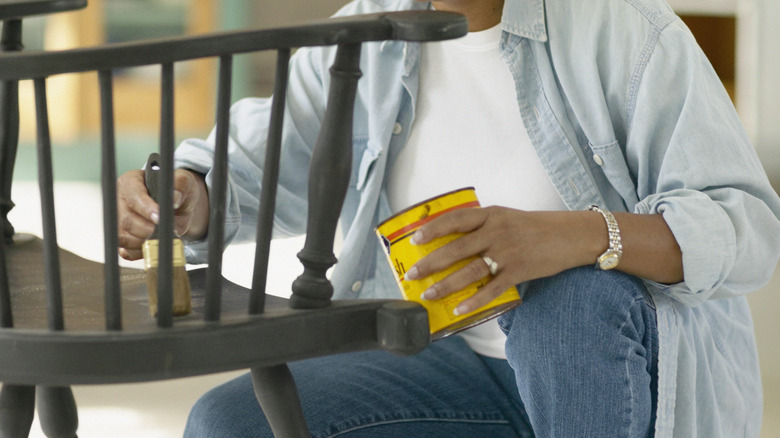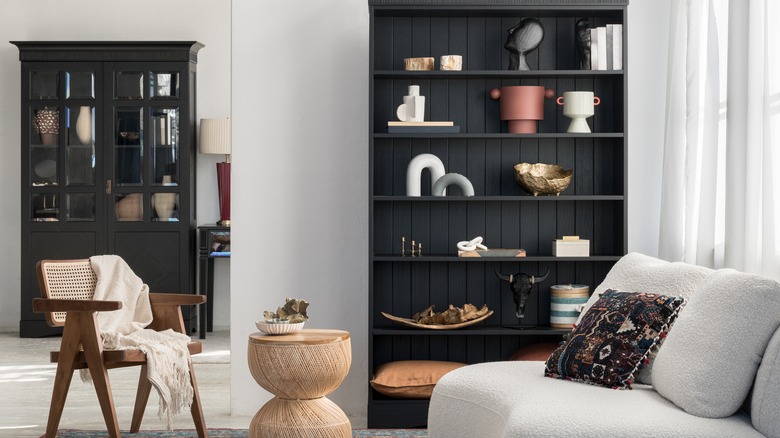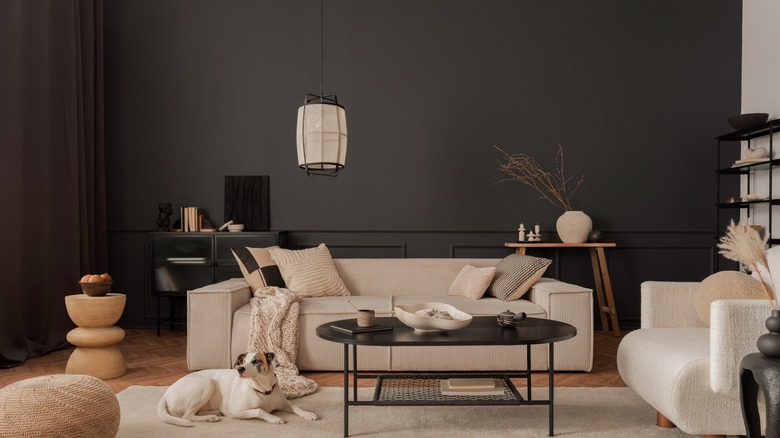Why You Might Want To Rethink Painting Furniture Black, According To A Pro
Freshening old furniture with a fresh coat of paint is a great way to give dated pieces a second life by helping them look new again. Though black is a sleek and sophisticated color, it may not be the most practical choice for your furniture. Painting a large piece of furniture black, such as a whole-wall entertainment center or a wall of cabinets, can also easily overwhelm your space and make the room look much smaller than it actually is, which is much easier to do when your room isn't all that big to begin with.
Plus, everyday realities such as fingerprints, dust, crumbs, and pet hair will also show up much more easily on furniture that is painted black, which has a way of making it look constantly dirty regardless of how often you clean it. Though black furniture might look stunning immediately after painting, it won't take long for signs of wear to become annoyingly evident. Knicks and scratches on the surface of the furniture painted black will show up more prominently, thanks to the stark contrast in color from the paint to the wood beneath. "I've been in too many houses that have painted their maple cabinets with a dark color to chase a trend, and now they look terrible with a little wear and tear on them," says realtor Brad Officer via Apartment Therapy. Though sure to make a statement in your home, black furniture tends to be higher maintenance, and for many, isn't worth it.
The trouble with black painted furniture
If you choose to paint your furniture black because you're going for a chic, polished look, be aware that you will likely need to occasionally touch up the paint. This is especially true if it's a piece of furniture that gets a lot of use, like the nightstand by your bed or your dining room table. If you don't want to commit to the possibility of having to redo some of your hard work down the road and know that the obvious appearance of imperfections will bother you, you may want to consider painting your furniture a lighter, less dramatic color that won't show wear and tear as much.
Before painting built-in furniture such as your cabinets black, it's also important to consider how doing so may affect the resale of your house someday, as some buyers may not like the prominent use of such a dark color — and black will be much more difficult for them to paint over than lighter shades. Black-painted furniture also absorbs a lot more sunlight than other colors, which can lead to the accelerated fading of your paint job, especially if it is in an area of the home with a lot of direct sun exposure.
How to do black
It can be tricky to use black in your space, but it's not impossible. "Stick to dark colors on the walls and lighter furnishings and linens to balance the room," says Benjamin Moore Color and Design Expert Hannah Yeo via Country Living. Not only will this prevent even the slightest amount of dust or the presence of scratches and wear from looking obvious, but using dark colors on the walls can actually help your space look larger when balanced out with lighter furniture. "Deep colors blur the edges of walls, creating an illusion of an endless and expansive room."
If you choose to use black furniture in your space, think about balancing it out with a more subdued tone on the wall, and opt to use furniture color that can't easily be scratched or nicked, such as a comfy fabric sofa. If you still want to paint your furniture black, consider choosing a piece that won't take up a huge portion of the room to the point it overwhelms it. If you are willing to risk the likelihood of your black-painted furniture showing wear and damage easily and are okay with probably having to touch it up occasionally, choose a black paint with a glossy finish. Matte black paint, for example, will show dust and other imperfections on the surface much easier, so choosing a finish with a high gloss or adding a glossy topcoat afterward can help mask at least some of the blemishes.


